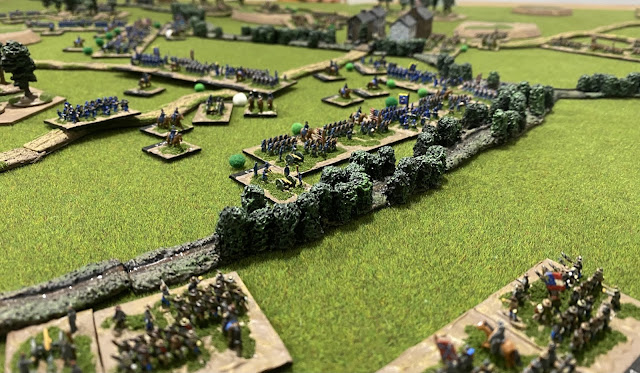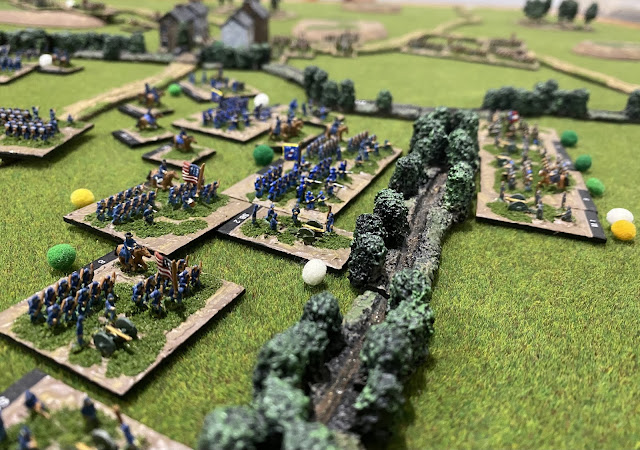Friday evening and it was time to revisit the American Civil War. Our fictional engagement, set in June 1863, found Fighting Joe Hooker intercepting Lee’s Army of Northern Virginia after Chancellorsville.
As Lee pushed north Hooker shadowed him. A portion of Lee’s army advance further to the west but Longstreet’s Corps, screened by Stuart’s cavalry, advanced further east. On the 17th June Confederate and Union cavalry clashed along Little River, near the town of Aldie. By the 18th both Lee and Hooker simultaneously determined to reinforce their positions, withdrawing their cavalry and committing their infantry.Hooker would eventually commit four corps to battle. However, by noon only Warren’s II Corps and Howard’s XI Corps were on the field. Marching to their support were French’s III Corps and Sedgwick’s VI Corps. Each corps comprised two or three divisions each of 3,000 to 4,500 bayonets. Lee in contrast could call on only two corps. In particular Longstreet’s I Corps and A.P. Hill’s III Corps. Though again not all were deployed on the field initially. Indeed, by noon only two divisions from Longstreet’s Corps were supported by one of Hill’s, that of Heth’s. Unlike the understrength Union divisions each Rebel division contained at least 6,000 bayonets.
Lee deployed Heth’s division south of the town. Longstreet deployed one of his divisions around Aldie and along the nearby banks of Little River. The other was to advance north of the town and cross a tributary of Little River as soon as practicable. It is worth noting that Little River meandered first east from the Blue Ridge mountains before turning briefly north around Aldie. It again turned east just north of the town where it was joined by a south flowing tributary.
Hooker meanwhile ordered Warren to advance his corps, comprising three divisions being those of Caldwell, Gibbon and Hays, in the centre. They were then to deploy opposite the town of Aldie and engage the enemy with artillery. Further, Hooker decided to refuse his right but press forward his left. This advance on the left was to be undertaken by Howard’s XI Corps.
The battle was now to become confusing as Lee and Hooker both pressed for advantage along the river. Each would be reinforced but equally neither reinforcement was sufficient to deliver significant advantage.
Hooker’s advance on the left was initially to show potential. While Union artillery in the centre belched fire on the enemy centre the turning movement looked likely to unhinge the Rebel right and centre.
Fearing catastrophe Lee ordered the Confederate units to the south of Aldie to retire. Warren could now cross the river but he was concerned by reports of Rebel reinforcements and until he was reinforced determined not to cross.
Back in the centre Pickett’s Division was pressing the much smaller Union Division under Gibbon just north of Aldie. Hooker reinforced this division with various artillery batteries. Eventually 36 Union guns were deployed here forcing the Pickett’s brigades back.
Above and below the area where Pickett’s Division pressed the Union line. Below, a more general view.
Lee meanwhile was trying to reinforce both his left and right. Pender’s Division, from Hill’s III Corps, was dispatched to reinforce and extend the Confederate right. Their arrival was sufficient to prevent a renewed Union attack. Below, in the background, Pender’s Division moves forward to reinforce the Confederate right.
Above, the Union left before Confederate guns encouraged the Union line to fall back twice forming at right angles to their original position. This, along with the general situation can be seen below.
Undeterred these same Rebel divisions repositioned nearer the Little River tributary and applied pressure on the corner of the Union line.
But this attack was Lee’s final roll of the dice. With darkness finally drawing the fighting to a close both commanders considered the cost of the fighting. Hooker’s casualties had mainly fallen on two of his small divisions, those of Gibbon and Hays. His other divisions had taken some damage but nothing of significance. The Confederates meanwhile had taken considerably more casualties. Like the Union army these had generally been dispersed across a number of divisions. The exceptions being those of the divisions of Pickett and Heth. Both these divisions had suffered heavy casualties and even Lee was left pondering how they would perform if he was able to continue his march north.
The battle was of course fictional and developed with the Road to Glory Scenario System with both armies comprising 4,000 points. Four players were involved, with Alastair and Richard commanded the Rebels forces while Barrie and I the Union. The miniatures are all from my own collection and are from Heroics & Ros’ 6mm range.








Comments
Post a Comment